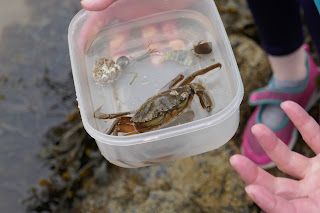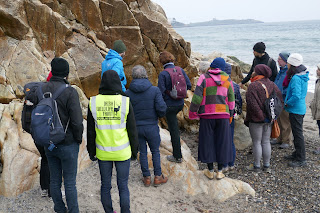IWT Dublin Branch went bird watching at Bull Island this January. Our guide was the excellent John Fox and there were lots of wintering birds to see along the causeway. We saw plenty of ducks, including pintails, shovelers, shelduck and teal. Other birds included curlews, godwits, lapwings and of course brent geese. There was a good turnout, and the weather was cold but dry. A satisfying morning's birdwatching was had by all.
Showing posts with label Coast and Marine. Show all posts
Showing posts with label Coast and Marine. Show all posts
Tuesday, 14 January 2020
7th January 2020 - Green Drinks Ireland through birds
January's Green Drinks was a drinks reception to celebrate the publication of 'Ireland through Birds' by Conor W. O'Brien. This fascinating and insightful book on some of Ireland's most elusive birds was launched by Dr. Tim Stott, TU Dublin. There was a great turnout on the night, and Conor sold a fair few copies! You can buy a copy of Conor's book from Merrion Press
The book launch was then followed by a talk by author and bird expert Anthony McGeehan on the birds of Inishbofin, which is a crossroads for migratory birds where unusual species such as North American warblers can be found. Inishbofin also has another advantage in that there are no magpies on the island!
Monday, 13 January 2020
10th November 2019 - Fossil hunting in Portmarnock
1st October 2019 Green Drinks - Cherish Project
The October Green Drinks talk was by Kieran Craven of CHERISH (Climate Heritage & Environments of Reefs, Islands and Headlands). CHERISH is an EU funded Ireland - Wales project, that will increase cross-border knowledge and understanding of the impacts (past, present and near-future) of climate change, storminess and extreme weather events on the cultural heritage of reefs, islands and headlands of the Irish Sea. This will be one of the most important ways that Ireland will be affected by climate change, so it is important to understand its impact.
Monday, 9 September 2019
25th August 2019 - Rockpooling in Portmarnock
The August outing of the Dublin Branch of IWT saw us rockpooling in Portmarnock, led by our knowledgeable volunteers Kevin and Leyla. Overall there were some 35 participants - mainly young kids, and the weather was fine, but a bit dull. Kevin and Leyla were absolutely wonderful, and helped everyone to find lots of really cool things. As well as both brittle starfish and a common starfish, some fish species were found including Rock Goby, blenny, butterfish and a 5 bearded rockling.
Other highlights included a nudibranch - orange clubbed sea slug (Limacia clavigera), which was feeding on the sea mats (bryozoans) attached to rocks in the rock pools. We also found Elysia viridis, or the sap-sucking slug (photo below).
Some of the birds that hung around with us during the rockpooling included cormorants, common tern, heron gulls, greater black-backed gulls, oystercatcher and turnstones.
Other highlights included a nudibranch - orange clubbed sea slug (Limacia clavigera), which was feeding on the sea mats (bryozoans) attached to rocks in the rock pools. We also found Elysia viridis, or the sap-sucking slug (photo below).
Some of the birds that hung around with us during the rockpooling included cormorants, common tern, heron gulls, greater black-backed gulls, oystercatcher and turnstones.
As well as all the wildlife, Kevin and Leyla talked to the children about marine pollution (plastic), and sure enough several kids picked up plastic items which they found in the rock pools. a very enjoyable and enlightening day was had by all.
Monday, 15 July 2019
7th July - Bull Island Wildflower Walk
Dublin Branch held its annual Bull Island wildflower walk led by Niall Mac Coitir of IWT Dublin Branch. This was a particularly good year, with an amazing variety of wildflowers to be seen, including six species of orchid! The six species were early purple orchid, common spotted orchid, pyramidal orchid, marsh helleborine, twayblade, and the elusive bee orchid. Other wild flowers seen were lady's bedstraw, restharrow, wild violets, hares foot clover, bird's foot trefoil, centaury and eyebright. It is not an exaggeration to say that the display rivals anything that can be seen in the Burren.
 |
| Common Spotted Orchid |
 |
Another common spotted
- they come in a variety of colours
|
 |
| Twayblade orchid with its green flowers |
 |
| Wild Violet or pansy |
 |
| Marsh Helleborine |
 |
| Pyramidal orchid |
Green Drinks 2nd July - Marine Protected Areas
For July's Dublin Green Drinks Regina Classen, of the IWT talked about the aims of the Bigger and Better Marine Protected Areas (MPA) initiative. Regina, IWT co-ordinator, campaigns in partnership with Coastwatch and Seas at Risk to promote the establishment of a Marine Protected Areas Network. MPAs are a proven way to achieve much needed ecosystem restoration, sustainable fishing and climate change mitigation. In theory, MPAs provide safe havens for animals and plants to grow and reproduce without the threat of human activity. An properly policed and extensive MPA network would provide a vital safe haven for wildlife. You can read more about the MPA campaign on the IWT's website: IWT Campaign 'Bigger and Better'
Monday, 1 July 2019
June 9th and 22nd - Ireland's Eye Trips
Dublin Branch held its annual Ireland's Eye trips on 9th and 22nd June, and as usual both trips were booked out. We were lucky with the weather as there was no rain, and our guide John Fox did an excellent job on both occasions. However, there were altogether fewer birds and chicks than in the past, and NO peregrine Falcons. There was also an unusual profusion of Hogweed everywhere. Despite this the trips were both enjoyable and informative.
Thursday, 23 May 2019
31st March - Killiney Beach Walk
This month Kieran Craven of CHERISH brought us on a walk along Killiney Beach. CHERISH (Climate Heritage & Environments of Reefs, Islands and Headlands) is an EU funded Ireland - Wales project, that will increase cross-border knowledge and understanding of the impacts (past, present and near-future) of climate change, storminess and extreme weather events on the cultural heritage of reefs, islands and headlands of the Irish Sea.
Kieran told us all about the the geology of the Killiney Beach area, including the fascinating fact that granite from Ailsa Craig in Scotland is to be found on the beach - carried there during the last Ice Age! Kieran also told us how the whole of Dublin Bay is at risk from rising sea levels due to Climate Change.
You can learn more about the CHERISH Project at http://www.cherishproject.eu/en/
 |
| Kieran talks about tectonic forces |
 |
| A look at some of the different rock types to be seen |
 |
Coastal erosion is happening at Killiney
and will only get worse with climate change
|
Tuesday, 12 February 2019
January 6th - Bull Island Bird Watching
The January outing of the Dublin Branch was the ever popular bird watching event on Bull Island. There was a good turn-out for the event, with benign weather conditions and a calm surface on the water. Led by the expert John Fox of Birdwatch Ireland we saw plenty of birds: apart from 5 different varieties of gulls, there were geese (mainly Brent), ducks (shelduck, widgeon, teal, shoveler, pintail, mallard), all sorts of waders (redshank, black-tailed godwit, dunlin, curlew, turnstone, lapwing) and, of course, herons. All in all a good day out.
 |
| Black Tailed Godwit |
 |
| Shelduck |
Thursday, 13 September 2018
Rockpooling Event - Sept 2nd
There was a great turnout for the IWT Dublin Branch's rockpooling event in Portmarnock. The weather was sunny and the kids (and adults too) saw lots of little sea creatures, including lion's mane jellyfish, barnacles, limpets, winkles and whelks, shrimps, crabs and brittle stars. A lovely day out!
 |
| Lions Mane jellyfish |
Monday, 30 July 2018
Bull Island Wildflower Walk - July 8th
The Dublin Branch held its annual Bull Island Wildflower Walk on July 8th led by branch member Niall Mac Coitir. The walk was very successful despite the drought, and as usual lots of wildflowers were seen. The elusive bee orchid evaded us this year as well, but several other species of orchid were spotted. Thanks to Brendan for the photos.
 |
| Marsh Helleborine |
 |
| Common Spotted Orchid |
 |
| Meadowsweet |
 |
| White Pyramidal Orchid |
 |
| Haresfoot clover with its fluffy flowers |
Tuesday, 3 July 2018
10th & 17th June 2018 - Trips to Ireland's Eye
For the eighth year in a row, the Dublin branch organised two trips to Ireland’s Eye. As in previous years, both outings were fully booked up and on both occasions participants fully appreciated the charm of this unique little island north of Howth Harbour. Fortunately, the weather also played its part and grey seals popping up in the water added to our enjoyment.
In order to reduce disturbance to nesting seabirds, Fingal County Council put up sign posts to the main sights and also started to form paths across the island by just strimming the vegetation. These simple measures appear to work well as most visitors we met seemed to stick to the paths.
It was thrilling to be close up to so many seabirds, including different species of gulls, terns and auks, fulmars, cormorants and shags, oystercatchers, and, of course, the star bird of the island, the gannet, nesting on the spectacular rock, the Stack. But what people enjoyed most were the many chicks running around already making a lot of noise and life difficult for their parents. Thankfully, John Fox (Birdwatch Ireland) was with us and answered the many questions people had in regard to the birds’ nesting, feeding, migration, behaviour and lifespan.
In order to reduce disturbance to nesting seabirds, Fingal County Council put up sign posts to the main sights and also started to form paths across the island by just strimming the vegetation. These simple measures appear to work well as most visitors we met seemed to stick to the paths.
It was thrilling to be close up to so many seabirds, including different species of gulls, terns and auks, fulmars, cormorants and shags, oystercatchers, and, of course, the star bird of the island, the gannet, nesting on the spectacular rock, the Stack. But what people enjoyed most were the many chicks running around already making a lot of noise and life difficult for their parents. Thankfully, John Fox (Birdwatch Ireland) was with us and answered the many questions people had in regard to the birds’ nesting, feeding, migration, behaviour and lifespan.
Photos courtesy of Brendan and Sam
Subscribe to:
Posts (Atom)



































